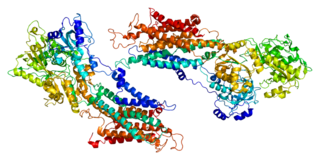
Salamandridae is a family of salamanders consisting of true salamanders and newts. Salamandrids are distinguished from other salamanders by the lack of rib or costal grooves along the sides of their bodies and by their rough skin. Their skin is very granular because of the number of poison glands. They also lack nasolabial grooves. Most species of Salamandridae have moveable eyelids but lack lacrimal glands.

Triturus is a genus of newts comprising the crested and the marbled newts, which are found from Great Britain through most of continental Europe to westernmost Siberia, Anatolia, and the Caspian Sea region. Their English names refer to their appearance: marbled newts have a green–black colour pattern, while the males of crested newts, which are dark brown with a yellow or orange underside, develop a conspicuous jagged seam on their back and tail during their breeding phase.

The southern crested newt is a terrestrial European newt. It is similar to the northern crested newt except larger and more robust.

Salamandrella keyserlingii, the Siberian salamander, is a species of salamander found in Northeast Asia. It lives in wet woods and riparian groves.

The Caucasian salamander is a species of stream-dwelling salamander in the family Salamandridae. This is a salamander of medium size, with a thin, elongated body. It is a relict species, endemic to the south-western Caucasus, in Georgia and Turkey. The subspecies M. c. janashvilii is found at Mt. Mtirala near Batumi and probably along the Black Sea coast.

The southern banded newt is a species of salamander in the family Salamandridae found in Armenia, Iraq, Israel, Jordan, Lebanon, Syria, and Turkey. This species has two subspecies - O. v. vittatus and O. v. ciliensis.

The false zokor is a species of rodent in the family Spalacidae. It is found in eastern Khentei and eastern Khingan in Mongolia and in the Onon River basin in Russia.

Ommatotriton or banded newts is a genus of salamanders in the family Salamandridae. The genus occurs in Western Asia and Caucasus. The species in this genus were formerly placed in the genus Triturus.

Sarcoplasmic/endoplasmic reticulum calcium ATPase 1 (SERCA1) also known as Calcium pump 1, is an enzyme that in humans is encoded by the ATP2A1 gene.

Interleukin-18-binding protein is a protein that in humans is encoded by the IL18BP gene.

Ceramide glucosyltransferase is an enzyme that in humans is encoded by the UGCG gene.
The Lake Baikal mountain vole or Olkhon mountain vole is a species of rodent in the family Cricetidae. It is found principally on the Olkhon and Ogoi islands on Lake Baikal, in southern Siberia. It is also found in a small part of the bordering mainland Russia, on the Baikal coast of the Irkutsk Oblast. It was originally described as a subspecies of the silver mountain vole. Since then, it has been synonymized with A. roylei in 1978, A. tuvinicus, and A. macrotis before reinstating it as a species. It is likely a sister species to A. tuvinicus.

A newt is a salamander in the subfamily Pleurodelinae. The terrestrial juvenile phase is called an eft. Unlike other members of the family Salamandridae, newts are semiaquatic, alternating between aquatic and terrestrial habitats. Not all aquatic salamanders are considered newts, however. More than 100 known species of newts are found in North America, Europe, North Africa and Asia. Newts metamorphose through three distinct developmental life stages: aquatic larva, terrestrial juvenile (eft), and adult. Adult newts have lizard-like bodies and return to the water every year to breed, otherwise living in humid, cover-rich land habitats.

Ommatotriton ophryticus, the northern banded newt, is a species of newt in the family Salamandridae. It is found in northeastern Turkey and western Caucasus in Georgia, Armenia, and southern Russia.
Tylototriton vietnamensis, the Vietnamese crocodile newt or Vietnamese knobby newt, is a species of newt in the family Salamandridae. It is known from four localities in northern Vietnam where it occurs in and near ponds within dense bamboo vegetation. It is quite likely that it also will be found in adjacent areas of China and possibly Laos. It is possible that specimens earlier identified as T. asperrimus are in fact T. vietnamensis. However, based on molecular genetic data, its closest relative is T. hainanensis.

The Balkan crested newt or Buresch's crested newt is a newt species of the crested newt species complex in genus Triturus, found in Southeastern Europe and Anatolia.

Triturus macedonicus, the Macedonian crested newt, is a newt species of the crested newt species complex in genus Triturus, found in the Western Balkan peninsula.

The Anatolian crested newt is a species of newt endemic to northern Anatolia in Turkey. Before its description in 2016, it was initially considered to belong to the southern crested newt and then the Balkan crested newt. The three species form a complex of morphologically indistinguishable cryptic species. Genetic data demonstrated the Anatolian crested newt to be distinct from the other two species, although it hybridises with the Balkan crested newt at its western range end.

The Caucasian smooth newt or Caucasian newt is a newt species found in the Caucasus region, from the Don river mouth in Russia to Georgia, and potentially Armenia, Azerbaijan, extreme northeastern Turkey and Iran. It occurs from sea level to 2,500 m (8,200 ft) elevation.















